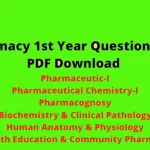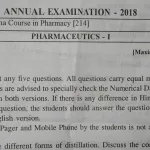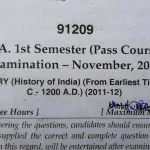The article provides a comprehensive collection of questions and answers for D Pharmacy 1st-year students based on the 2018 question paper. It covers all subjects, offering a useful resource for exam preparation. Each subject includes a minimum of 20 questions, with clear answers to aid understanding and revision.
Pharmaceutical Chemistry-I
Question: What is the molecular weight of Sodium Chloride?
Answer: The molecular weight of Sodium Chloride (NaCl) is 58.44 g/mol.
Question: Define molarity.
Answer: Molarity is the number of moles of solute per liter of solution.
Question: What is a buffer solution?
Answer: A buffer solution is a solution that resists changes in pH when an acid or base is added.
Question: Describe the properties of acids.
Answer: Acids are substances that donate protons (H+) and have a pH less than 7.
Question: What is the role of a catalyst in a chemical reaction?
Answer: A catalyst speeds up a chemical reaction without being consumed in the process.
Question: Explain the concept of oxidation and reduction.
Answer: Oxidation is the loss of electrons, while reduction is the gain of electrons.
Question: What is Avogadro’s number?
Answer: Avogadro’s number is 6.022 x 10^23, representing the number of particles in one mole of a substance.
Question: Define isotopes.
Answer: Isotopes are atoms of the same element with different numbers of neutrons.
Question: What is the pH of a neutral solution?
Answer: The pH of a neutral solution is 7.
Question: Explain the process of titration.
Answer: Titration is a technique used to determine the concentration of a solution by reacting it with a standard solution.
Question: What are electrolytes?
Answer: Electrolytes are substances that dissociate into ions when dissolved in water, conducting electricity.
Question: Define atomic number.
Answer: The atomic number is the number of protons in the nucleus of an atom.
Question: What is the difference between a solute and a solvent?
Answer: A solute is a substance that is dissolved in a solvent, forming a solution.
Question: Describe the concept of a mole in chemistry.
Answer: A mole is a unit that represents 6.022 x 10^23 particles of a substance.
Question: What is the significance of the periodic table?
Answer: The periodic table organizes elements based on their atomic number and properties.
Question: Explain the law of conservation of mass.
Answer: The law of conservation of mass states that mass cannot be created or destroyed in a chemical reaction.
Question: What are covalent bonds?
Answer: Covalent bonds are chemical bonds formed by the sharing of electrons between atoms.
Question: Define ionization energy.
Answer: Ionization energy is the energy required to remove an electron from an atom in its gaseous state.
Question: What is the difference between endothermic and exothermic reactions?
Answer: Endothermic reactions absorb heat, while exothermic reactions release heat.
Question: Describe the structure of the atom.
Answer: An atom consists of a nucleus containing protons and neutrons, surrounded by electrons in orbitals.
Pharmaceutics-I
Question: What is the role of a pharmacist?
Answer: A pharmacist is responsible for dispensing medications and providing information on their proper use.
Question: Define pharmaceutics.
Answer: Pharmaceutics is the science of preparing and dispensing drugs.
Question: What is the purpose of dosage forms?
Answer: Dosage forms are designed to deliver the drug effectively and safely to the body.
Question: Explain the process of tablet manufacturing.
Answer: Tablet manufacturing involves the compression of powdered drugs into solid forms for oral administration.
Question: What are the advantages of liquid dosage forms?
Answer: Liquid dosage forms are easier to swallow and allow for flexible dosing.
Question: Describe the role of excipients in pharmaceutical formulations.
Answer: Excipients are inactive substances used to give shape, stability, and ease of administration to the drug.
Question: What is sterilization?
Answer: Sterilization is the process of eliminating all forms of microbial life from a substance or surface.
Question: Define bioavailability.
Answer: Bioavailability is the proportion of a drug that enters the bloodstream and has an active effect.
Question: What is the significance of drug stability?
Answer: Drug stability ensures that a drug maintains its potency and safety throughout its shelf life.
Question: Explain the concept of pharmacokinetics.
Answer: Pharmacokinetics studies how a drug is absorbed, distributed, metabolized, and excreted in the body.
Question: What is the role of preservatives in pharmaceuticals?
Answer: Preservatives prevent the growth of microorganisms in pharmaceutical products.
Question: Define emulsion.
Answer: An emulsion is a mixture of two immiscible liquids where one is dispersed in the other in the form of small droplets.
Question: What is the difference between ointments and creams?
Answer: Ointments are semi-solid preparations with a greasy texture, while creams are semi-solid emulsions with a smoother texture.
Question: Describe the process of granulation.
Answer: Granulation is the process of forming larger particles (granules) from powders to improve flow and compressibility in tablet manufacturing.
Question: What is the importance of dissolution testing?
Answer: Dissolution testing measures how quickly and efficiently a drug is released from its dosage form.
Question: Explain the concept of controlled-release dosage forms.
Answer: Controlled-release dosage forms are designed to release the drug slowly over time, reducing the frequency of dosing.
Question: What is a suppository?
Answer: A suppository is a solid dosage form intended for insertion into body cavities, where it melts or dissolves.
Question: Define disintegration time.
Answer: Disintegration time is the time it takes for a tablet to break down into smaller fragments in the digestive tract.
Question: What is the role of a coating on tablets?
Answer: The coating on tablets protects the drug from environmental factors and masks unpleasant tastes.
Question: Describe the importance of packaging in pharmaceuticals.
Answer: Packaging protects the drug from contamination, light, and moisture, and provides information for safe use.
Pharmacognosy
Question: What is pharmacognosy?
Answer: Pharmacognosy is the study of natural products, especially plants, used as drugs.
Question: Define alkaloids.
Answer: Alkaloids are naturally occurring compounds, mostly derived from plants, that have pharmacological effects.
Question: What are glycosides?
Answer: Glycosides are compounds formed from a sugar and a non-sugar substance, often with medicinal properties.
Question: Explain the significance of medicinal plants.
Answer: Medicinal plants are used for their therapeutic properties and have been a source of drugs for centuries.
Question: What is the role of tannins in plants?
Answer: Tannins are plant compounds that have astringent properties and can be used in medicine for their anti-inflammatory effects.
Question: Define essential oils.
Answer: Essential oils are volatile, aromatic oils extracted from plants, used for their therapeutic and aromatic properties.
Question: What is the difference between an infusion and a decoction?
Answer: An infusion is made by steeping plant material in hot water, while a decoction involves boiling the plant material to extract active ingredients.
Question: Describe the process of extraction in pharmacognosy.
Answer: Extraction involves separating the active ingredients from plant material using solvents to create medicinal products.
Question: What are flavonoids?
Answer: Flavonoids are a group of plant compounds with antioxidant and anti-inflammatory properties.
Question: Explain the role of resins in plants.
Answer: Resins are sticky substances produced by plants, often with antiseptic and healing properties.
Question: What is the significance of herbal medicine?
Answer: Herbal medicine uses plants and their extracts to treat illnesses and promote health.
Question: Define phytochemistry.
Answer: Phytochemistry is the study of the chemicals derived from plants and their effects on health.
Question: What are terpenoids?
Answer: Terpenoids are a large class of organic compounds produced by plants, often with strong aromatic qualities and medicinal properties.
Question: Describe the importance of quality control in herbal medicine.
Answer: Quality control ensures that herbal medicines are safe, effective, and free from contaminants.
Question: What is the role of saponins in plants?
Answer: Saponins are plant compounds that create foam when shaken in water and have various medicinal properties, including cholesterol-lowering effects.
Question: Explain the concept of standardization in herbal medicine.
Answer: Standardization ensures that herbal products contain consistent levels of active ingredients for predictable therapeutic effects.
Question: What are the uses of bitter principles in medicine?
Answer: Bitter principles are plant compounds used to stimulate appetite and digestion.
Question: Define crude drugs.
Answer: Crude drugs are natural substances used in their raw or minimally processed form for medicinal purposes.
Question: What is the role of a herbarium in pharmacognosy?
Answer: A herbarium is a collection of preserved plant specimens used for research and reference in pharmacognosy.
Question: Explain the importance of conservation in medicinal plant use.
Answer: Conservation ensures the sustainable use of medicinal plants, preserving them for future generations.
Human Anatomy and Physiology
Question: What is the function of the heart?
Answer: The heart pumps blood throughout the body, supplying oxygen and nutrients to tissues and removing waste products.
Question: Define homeostasis.
Answer: Homeostasis is the process by which the body maintains a stable internal environment despite external changes.
Question: What are neurons?
Answer: Neurons are nerve cells that transmit electrical signals in the nervous system.
Question: Explain the role of the kidneys.
Answer: The kidneys filter blood to remove waste products and excess fluids, producing urine.
Question: What is the structure of a cell membrane?
Answer: The cell membrane is a phospholipid bilayer with embedded proteins, controlling the movement of substances in and out of the cell.
Question: Define the respiratory system.
Answer: The respiratory system is responsible for gas exchange, bringing oxygen into the body and removing carbon dioxide.
Question: What are hormones?
Answer: Hormones are chemical messengers produced by glands that regulate various functions in the body.
Question: Describe the function of red blood cells.
Answer: Red blood cells transport oxygen from the lungs to tissues and carry carbon dioxide back to the lungs for exhalation.
Question: What is the significance of the skeletal system?
Answer: The skeletal system provides structure, protects organs, and facilitates movement in the body.
Question: Define the digestive system.
Answer: The digestive system breaks down food into nutrients that the body can absorb and use for energy, growth, and repair.
Question: What are the functions of the liver?
Answer: The liver processes nutrients, detoxifies harmful substances, produces bile, and plays a role in metabolism.
Question: Explain the role of the immune system.
Answer: The immune system defends the body against infections and diseases by identifying and destroying pathogens.
Question: What is the structure of the skin?
Answer: The skin consists of three layers: the epidermis, dermis, and hypodermis, providing protection and regulating temperature.
Question: Describe the process of blood clotting.
Answer: Blood clotting is the process by which blood changes from a liquid to a gel, forming a clot to prevent excessive bleeding.
Question: What are the components of the central nervous system?
Answer: The central nervous system consists of the brain and spinal cord, controlling most functions of the body and mind.
Question: Define the endocrine system.
Answer: The endocrine system is a network of glands that produce hormones to regulate metabolism, growth, and other bodily functions.
Question: What is the function of the pancreas?
Answer: The pancreas produces enzymes for digestion and hormones like insulin to regulate blood sugar levels.
Question: Describe the circulatory system.
Answer: The circulatory system transports blood, nutrients, gases, and waste products throughout the body.
Question: What is the role of the lymphatic system?
Answer: The lymphatic system helps protect the body from infections, maintains fluid balance, and removes waste from tissues.
Question: Explain the importance of the muscular system.
Answer: The muscular system allows movement, maintains posture, and generates heat in the body.
Latest Posts
- Step-by-step guide to download and apply for jee mains admit card 202
- Comprehensive 2025 government holidays and recruitment details for job seekers
- JEE Mains Admit Card 2025: Your Step-by-Step Guide to Downloading the Hall Ticket
- Everything You Need to Know About 2025 Government Holidays Recruitment
- Comprehensive Guide to rrb d group recruitment 2025 – Eligibility, Vacancies, and Application
- Detailed guide to nps trust recruitment 2025 vacancies, eligibility and apply process
- Comprehensive guide to hpcl recruitment 2025 notification, vacancies, and application process
- ignou bed admission 2025 complete recruitment guide with eligibility and process
- Comprehensive Guide to Indian Army Agniveer Recruitment 2025 Notification and Jobs
- Everything You Must Know About CBSE Board Exams 2025 Changes & New Rules




